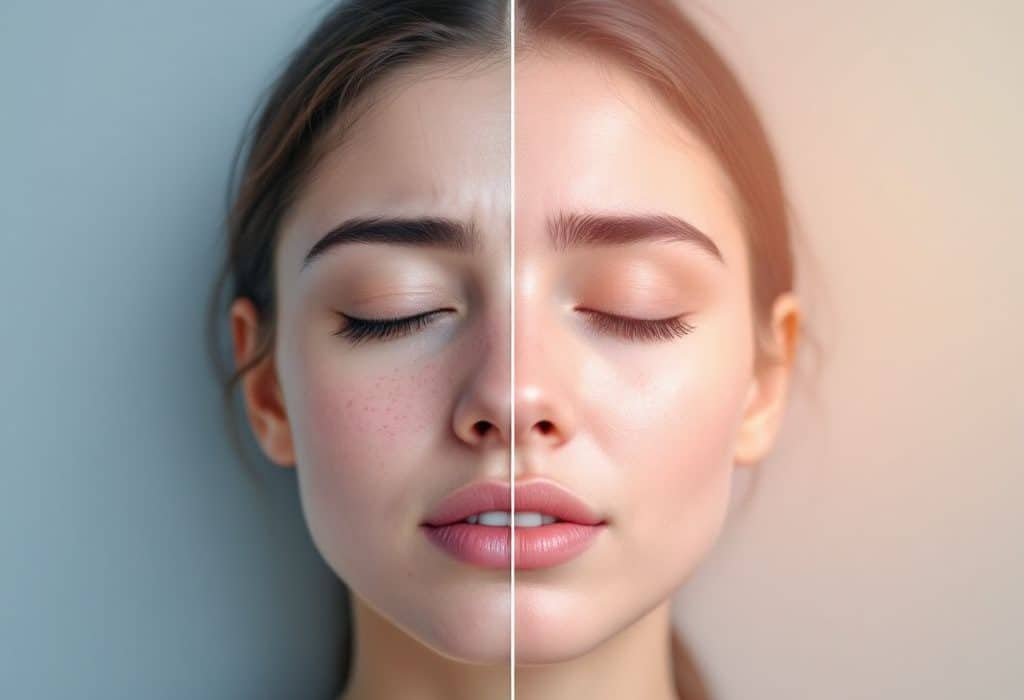Ever wondered why your skin seems to rebel just when you need it to be on its best behavior? It’s like it knows you have a big meeting or an important date, and poof—there’s the stress-induced breakout. Today, let’s have a chat about the science behind your skin’s hyper-sensitivity to stress, a concept often referred to as the “stress response.” This isn’t just some hypothetical blame game for your blotchy skin; it’s actually rooted in science. So, sit back, relax (that’s important!), and let’s dig into the hows and whys of your skin showing its frustrations at precisely the wrong moments.
What Is Skin Stress Response?
The skin, believe it or not, isn’t just a passive barrier—it’s a living, reactive organ. Yeah, I know—crazy, right? It’s perpetually engaged in a complex conversation with your nervous and immune systems. Stress response is your body’s way of coping with threats, whether they’re physical, like an injury, or psychological, like that all-important deadline looming at work.
Our bodies are smart systems, anticipating and reacting to stressful situations via this response. But these reactions aren’t just processing in your brain; your skin is also in on the act. When stress signals are sent out, think of your skin as waving its tiny cellular flags, indicating something’s going down at the cellular level—enter the “cellular reaction.”
The Science of Skin Stress: Breaking It Down
So, what exactly happens when your skin picks up on stress? Here’s the science without the boring bits:
- The Signal: Everything begins in the brain, home of the stress-response HQ. When it gets a signal—think fierce email from the boss or an argument with a loved one—the brain releases chemicals like cortisol and adrenaline.
- The Release: These stress hormones then hit the bloodstream, racing toward your skin. Historically, this was a survival mechanism, helping our ancestors outrun giant saber-toothed tigers. For modern-day you, it spells trouble for that clear complexion you’re aiming for.
- The Reaction: At the skin level, cells respond almost immediately. Cortisol triggers the activation of sebaceous glands—those little fellows doing the noble cause of keeping your skin hydrated. Too much stim, though, and hello oily skin and breakouts.
- The Immune & Inflammatory Cues: Your skin starts up an inflammatory response to prepare for potential injury. This inflammation can present itself as redness, puffiness, or those fantastic spots that show up just when you’re trying to put your best face forward.
The Aging Angle: More Than Just Wrinkles

Aging isn’t just about adding another candle to the cake. It’s happening underneath, driven in part by how your skin handles stress over time. When cortisol is hanging out in your body on the regular, it can slow down the skin’s ability to replenish and repair. Fast-forward a few years of chronic stress bombardment, and, well… those anti-aging creams become your best friend.
Ever noticed how stress seems to make you feel older overnight? Part of that feeling is from your skin literally aging more rapidly due to this cellular stress-response mechanism. Stuff’s wild, right?
Navigating Away from Stress-Induced Havoc
It’s clear your stress response doesn’t always have your back when it comes to beauty. So, how do you curb your skin from throwing a tantrum every time life gets a little overwhelming? Here’s the low-down on keeping those prickly responses in check:
- Chill: No, seriously. Finding ways to manage stress is key. Meditation, deep breathing, or just a quick walk around the block can do wonders.
- Sleep Matters: Really get that beauty sleep. Cortisol levels regulate during restful slumber, giving your skin much-needed recovery time.
- Feed Your Skin Like a Friend: Nutrient-rich foods fuel your skin’s resilience against the inevitable stress response. Fruits and veggies like berries, oranges, and dark leafy greens with potent antioxidants can be particularly helpful.
- Stay Hydrated: If your skin is insanely dry or worryingly shiny, you’re either washing off necessary oils or becoming a grease factory. Proper hydration helps balance things out.
- 5. **Skincare Routine, STAT: Keep it simple and consistent. Use products that soothe rather than irritate your skin. Ingredients like hyaluronic acid and niacinamide can be lifesavers for stressed skin.
Time to Talk Myths

We all have our pet theories about what causes skin disasters. Here’s a spotlight on common myths and a little truth serum for the matter.
**Myth 1: Chocolate Causes Pimples.** Not quite! While diet affects skin health, the chocolate-pimple connection isn’t straightforward. But hey, moderation is always a Golden Rule.
**Myth 2: Skin Exfoliation Solves Everything.** There’s such a thing as too much scrubbing. Over-exfoliating can irritate the skin and worsen stress responses. Less is sometimes more.

**Myth 3: Sunscreen Isn’t Necessary When It’s Cloudy.** UV rays are sneaky and can stress your skin out even on cloudy days—sunscreen every day is your skin’s safety chat.
Circling Back: Stress as a Natural Experience
The reality is you can’t avoid stress altogether. It’s part of being human! What we can do, though, is manage our reactions to it and minimize its effects on our skin and body. Much like a friend who gets on your nerves but can be your best ally, stress keeps us alert. The real trick is nurturing a healthier relationship with it so that its effects aren’t front and center on your face every morning.
Constant engagement with stress consumes your skin’s resources, making that stress response even easier to trip. Keep your skin educated about gentler approaches. You’ll thank yourself in the long run. Trust me on this one!
Let’s Wrap This Up
So there you have it—your skin’s business side unfurled! From feeling fragged under stress to discovering cellular reactions at work, the journey of understanding your skin stress response might just be one of your most valuable skincare insights yet.
Remember, your skin’s in cahoots with the rest of your body, and learning to speak its language isn’t just enlightening—it’s essential for keeping things calm under pressure. Next time you’re feeling the heat, remember those little cellular warriors under your skin and give them a reason to stay on your side. Breathe, hydrate, and nourish—not just your skin, but your whole being.
We’ve covered quite the gamut from internal science to practical self-care solutions. So, when your skin acts out, you’ll know what’s going on under the hood and have the tools to help it calm down. Let’s toast to stress-response resilience and say cheers to glowing, stress-resistant skin!
Frequently Asked Questions
What is the stress response?
The stress response, also known as the “fight or flight” response, is an emergency mechanism the body mobilizes to give us an extra edge or “super-strength” when dangerous situations occur. It is triggered by the perception of danger and involves the secretion of stress hormones like adrenaline and cortisol, which prepare the body for immediate action[3][5].
How does the stress response work in the body?
The stress response is initiated by the hypothalamus, which activates the pituitary gland and the adrenal medulla. The pituitary gland secretes adrenocorticotropic hormone (ACTH), which stimulates the adrenal glands to release cortisol. The adrenal medulla secretes adrenaline, leading to increased heart rate, breathing, and blood pressure, and preparing the body for a fight-or-flight response. This response is managed by the sympathetic nervous system and suppressed by the parasympathetic nervous system once the threat is over[1][3][5].
What are the different phases of the stress response?
The stress response has two main phases: the Sympathetic Adrenomedullar System (SAM) and the Hypothalamic-Pituitary-Adrenal (HPA) system. The SAM phase is immediate and involves the release of adrenaline for short-term responses. The HPA system manages long-term stress responses through the release of cortisol. Additionally, the General Adaptation Syndrome (GAS) describes three stages: alarm, resistance, and exhaustion, which outline the body’s response to and recovery from stress[1][3][4].
What are the potential long-term effects of chronic stress?
Chronic stress, which involves the sustained release of cortisol over prolonged periods, can overwhelm the body’s coping mechanisms and impact health. It can lead to dysregulated cortisol secretion, affecting various bodily functions such as metabolism, immune response, and overall well-being. Chronic stress can also progress to burnout, characterized by the depletion of the body’s resources and insufficient production of cortisol[4][5].
References- Simply Psychology. (2023). What is the Stress Response.
- AnxietyCentre.com. (n.d.). The Stress Response.
- VA Mental Health. (2013). The Stress Response and How it Can Affect You.
- Katarina Gaborova. (2024). Enhanced Burnout Reduction Model and Guidelines for Interventions.



